Welcome to the fourth step in our free professional learning series on class and student blogging!
- Explain how comments are used on class blogs.
- Provide tips for teaching students quality commenting skills.
Why Comments Are Important
Kathleen Morris has shared some thoughts on why comments count in a blog post:
- Comments turn your blog from a static space into an interactive space.
- They allow for back and forth conversation which can lead to a huge amount of learning.
- The fact that comments aren’t instantaneous (like online chat) can fuel deeper reflections, responses, and research.
- Comments allow for feedback, constructive criticism, and the adding of ideas and opinions to the original post. The content can grow and evolve.
- It can be encouraging for students to know they have an authentic audience who can connect with them.
- Commenting can be an ideal way for parents to get involved in the classroom (virtual parent helpers!)
- A single comment can be the start of a fantastic working relationship or friendship. You never know where that can take you and/or your students.
The Blogging Cycle
Important parts of the blogging process include encouraging students to:
1. Read other students’ posts.
2. Comment on other students’ posts.
3. Write posts in response to other students’ posts.
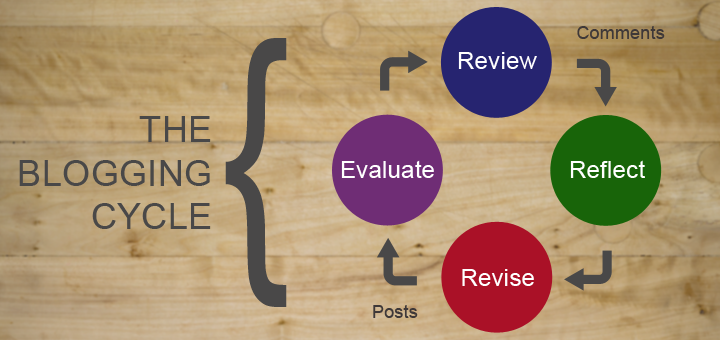
It’s amazing how even just a few comments can make students realize they are writing for a global audience — for many it’s incredibly motivating.
Must Watch Video
We recommend you watch The Possibility of Student Blogging by Andrea Hernandez and Slivia Tolisano.
This video provides an excellent explanation of the blogging, the commenting process, the impact of quality blogging on student literacy, and the importance of writing as part of a global audience.
Remember, discussions in comments are important for reflective learning. Comments that challenge or suggest alternative options encourage you to reflect, revise, evaluate, and review your thoughts.
Back to Top
How Comments Work
By default, comments are enabled on all newly created blogs, and a comment form will appear at the bottom of posts and pages where readers can respond to what you’ve written.
Note: Comments are disabled on pages by default and can be enabled.
Approved comments are displayed under the individual post or page. You just click on the post title or the comment link to read the comments.
Threaded comments allow readers to reply to other comments inline/nested which encourages better discussion and responses.
Here is an example of a threaded comment on a post:
Dealing With Comments
The great thing about comments is you have control over moderation and approval. Refer to the following support documents for more information on dealing with comments.
Examples Of Comments On Class Blogs
These examples of comments on class blogs to demonstrate just a few of the ways comments can be used by educators and students.
- Two Truths and One Lie: A Culture Exchange (Miss Jordan’s grade 3/4 students in Australia had a commenting conversation with some of their blogging buddies in the USA)
- Learning in 21 — You Are Invited (Grade 3 students wrote a comment to their teacher)
- St Charles Borromeo students run a Mystery Word competition that students can comment on.
- Roslyn Green’s high school history class (Night of Notables) and English class (G is for Gratitude) wrote some insightful reflections in their comments.
How To Add Comments
To leave a comment on a post, simply:
1. Click on the heading of the post you wish to comment on or the ‘comment’ link at the top or bottom of the post.
2. Scroll down the page to the comment form or click on Reply (to reply to a specific comment).
3. Enter your name and email address –- your email address is hidden and only the blogger sees it (If you are logged into your Edublogs account you won’t need to add these details).
4. Write your comment in the box.
5. Enter the anti-spam word.
6. Select ‘Notify me of followup comments via e-mail‘ if you want to get an email when other people comment (so you know if people reply to you etc.).
7. Click Post Comment
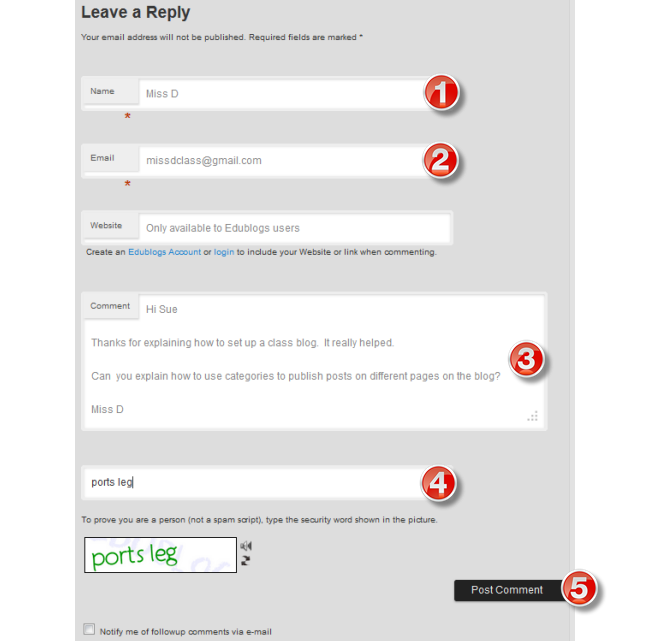
Below is a video from Kathleen Morris explaining how to add a comment for students.
Note: Email address isn’t required in her example as the email requirement has been disabled in Settings > Discussion.
Want to make your own ‘How to comment’ video? Try a free tool like Screencastify or Loom.
Teaching Quality Commenting Skills
If commenting skills are not taught and constantly reinforced, there can be a tendency for students to limit their comments to things like,
- “I like your blog!”
- “Awsom 🙂 🙂 🙂 🙂 🙂 :)”
- “Cool!!!!!!!!!!!!”
While enthusiasm is high with these sorts of comments, students are not developing their literacy skills or having meaningful interactions with other members of the blogging community.
Conversations in the comment section of a blog are such rich and meaningful learning experiences for students. Conversations begin with high quality comments.
Blogging is an authentic avenue for developing student literacy skills. When you invest the time in teaching, modeling, revising, and promoting high quality writing of comments, students can make great gains in their overall literacy development.
Set your standards high from the start and reap the rewards!
Developing strong commenting skills also provides a good foundation for when you move students on to writing posts on the class blog or their own student blogs.
The following diagram summarizes a scaffolded approach to blogging in the classroom. It begins with the teacher being responsible for the posts while the students learn quality commenting skills.
We explained this progressive model more in step three.
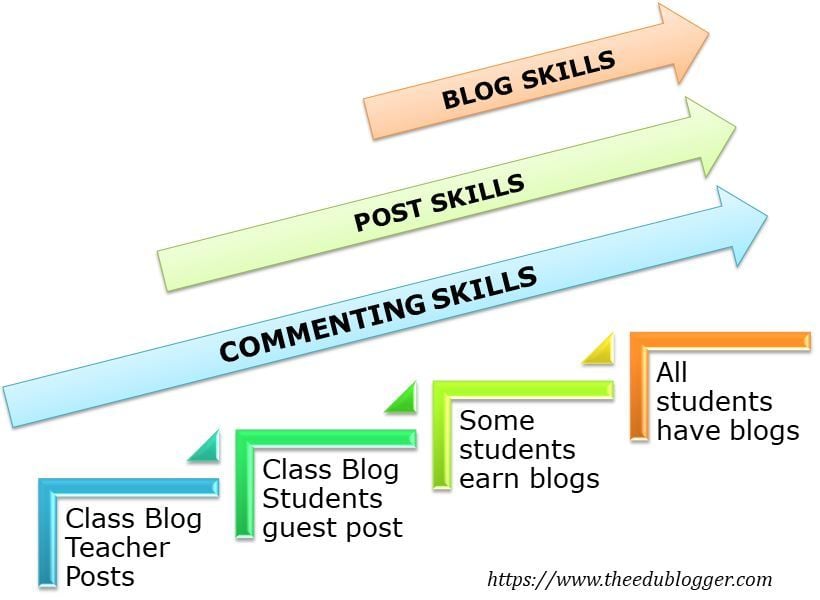
How To Teach Quality Commenting Skills
In her post on commenting, Kathleen Morris shares eight ideas to encourage a culture of quality commenting.
- Blogging guidelines: Set high standards to ensure students are using correct writing conventions and practicing things like asking questions, staying on topic, making connections, complimenting in a specific way etc. See below for examples.
- Be consistent: Consider spending a couple of minutes each day or a few times a week focusing on commenting as a whole class. You might read comments together, write replies together, and have students come up with constructive feedback. Embed blogging into your routine.
- Use mini lessons. You can embed on-the-spot commenting tutorials into whole class blogging time. You might choose a comment to reply to as a class. The teacher can model how to write a quality comment with input from students. Check out some mini lesson ideas Kathleen put together with annotated examples a number of years ago.
- Use explicit lessons. Come up with a few more detailed lessons on commenting. For example, Kathleen used to give her grade two students some example comments to sort. Older students could find examples themselves and analyze them on a much deeper level.
- Integrate. When you use literacy lessons to teach various conventions (like letter writing, editing, grammar, spelling, punctuation etc.) have students practice these concepts through commenting. If you have literacy rotations, blogging is always an excellent activity station!
- Involve parents. Family members have the potential to be regular commenters on your class blog. We need to bring this potential to life. Just one idea is sending parents an email asking them to comment on a specific post with their child. Well know blogger, Linda Yollis, gives parents suggestions, such as typing for their child but leaving errors for them to correct. Step six of this series offers lots of ideas on helping parents and students connect with the class blog.
- Connect with others. There are so many ways you can connect with other classes around the world to create authentic opportunities for both writing and receiving comments. The Student Blogging Challenge which begins in March and October each year is a good place to start. #Comments4Kids is a Twitter hashtag you can use and follow too.
- End with a question. A question at the end of a blog post is an invitation to comment. You can teach students about using open ended questions, and help them understand the etiquette of replying to comments too.
Six Activities For Developing Commenting Skills
Here are some suggestions for activities you can use to develop your students’ commenting skills.
1. Commenting videos
Videos can be a great way to introduce students to the art of commenting.
Watch this video by Linda Yollis’ students about leaving quality comments.
Linda’s students have also created this excellent video with tips for quality writing on blogs.
Watch Ten Tips For Great Blog Comments by Bloggin’ Frogs students.
Silvia Tolisano’s students put together this impressive report into quality commenting.
Check out Nicolas Weiss’ Leaving High Quality Blog comments video for quality commenting explained for high school students.
2. Create commenting guidelines for your blog
Facilitate a collaborative discussion with your students to create your own commenting guidelines.
Here are some examples of commenting guidelines to look at from different age groups:
- Ms. King and the Grade 1/2 Busy Bees are encouraged to write Wow Comments.
- Grade 5 teacher, Keith McCray uses a simple Star, Wishes, Wonder approach
- Huzzah in Canada is a grade 6/7 class that has a fairly detailed set of commenting guidelines with student input.
- Sometimes commenting guidelines have more of an academic focus, like these ones from the old English 10 blog.
- Kae Cunningham combined her blogging guidelines and commenting guidelines on one page on her high school blog.
- Heather Alexander’s TAG approach that she uses for her year 9-12 students could be used for any age. TAG stands for:
Tell them something you like about their work
Ask them a question
Give a suggestion
Remember, use others’ guidelines for ideas but don’t copy others’ work without permission and acknowledgment.
A page is a good place to document guidelines. Refer to Step 2: Set Up Pages for more information on pages.
As an alternative to displaying guidelines through text, you could get your students to create their own videos on writing quality comments.
Watch this Comments video shared by Andrea Hernandez made by a 5th Grade student.
3. Create a commenting guideline poster
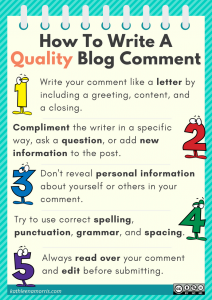 A poster is a great way to make a visual representation of your commenting guidelines.
A poster is a great way to make a visual representation of your commenting guidelines.
A poster could be made by the teacher or the students.
Display your poster in the classroom, on a blog page, and send it home to share with parents and caregivers.
You could make a digital poster in Canva, PowerPoint, or any number of online tools
Short on time? Kathleen Morris has shared her commenting guidelines poster on her blog which you’re welcome to download and use.
4. Develop a quality comment evaluation guide or rubric
Point system
Linda Yollis’ class uses a point system for evaluating comments. A one point comment is a general comment that doesn’t add much to the conversation. A two point comment is a good comment that adds something to the conversation.
Check out Linda Yollis’ evaluation guide and how she teaches commenting to see if you want to set up a quality comment evaluation guide for your class.
Rubric
Another idea for setting standards for commenting, writing, or blogging in general is using a rubric.
Teachers could make this to meet the needs of their class, or students could create their own.
Here are three examples:
- Kathleen Morris created a blogging rubric which isn’t restricted to a certain year level.
- Heather Alexander created this rubric for blog entries.
- Silvia Tolisano shares a blogging and commenting rubric on her Langwitches blog.
5. Get your students to practice commenting
Publish a blog post about commenting and what you define as a quality comment and then have your students practice leaving a “quality” comment on the post.
Check out Jan Smith’s “I’m New Here” post. It’s an excellent example of introducing students to reading student blog posts and learning how to write comments.
6. Try paper blogging
Paper blogging is a hands-on, concrete way of introducing students to writing posts and comments using paper and post-it notes.
You’ll find a detailed explanation of how to paper blog with your students here. You’ll find an example of using paper blogging activity with students here.
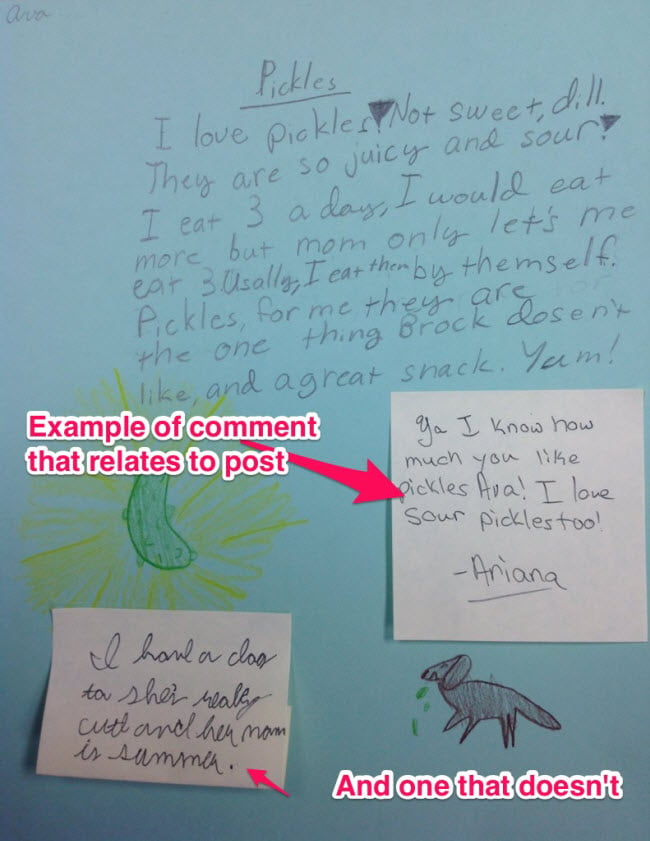
Other advice and tips
The following is Fiona Stafford’s reflection on commenting and strategies she uses with her Grade 6 students:
After some time, I noticed a stand-still in commenting. It appeared that students were posting a lot but not commenting, which limited the amount of student learning from their peers via feedback. So, over time, I incorporated a number of strategies to encourage the students to comment on other people’s blog posts. The different tactics I employed to enhance feedback via commenting were: allowing some time in class to do it; setting expectations to comment as a part of their weekly home learning; making it compulsory for parents to comment somewhere on their child’s blog site as confirmation that their home learning had been completed; making the majority of their home learning via their blogs; getting them to set a blogging goal in order to move forward with the process; and introducing a ‘what’s trending?’ page to our class blog. The rationale behind this page was to encourage students to suggest other students’ blog posts that were worthy of their attention and encourage people to give feedback. So far, this has been working. But, this is still an ongoing journey. This journey into the Blogosphere has and continues to provide just as much learning for me as it does my students.
Commonly Asked Comment Questions
There are some commonly asked questions that we receive at Edublogs Support. Let’s break them down.
1. How do you enable comments on pages?
Most Edublogs themes support comments on pages and by default comments are disabled on pages.
You can enable comments on pages using Quick Edit as follows:
1. Go to to Pages > All Pages
2. Locate the post or page you want to enable comments on.
3. Hover over its title to bring up its action menu.

4. Click on Quick Edit, deselect ‘Allow Comments’ and then click on Update.
2. Why won’t comments display on pages?
Most Edublogs themes support comments on pages, however, there are a few themes that don’t.
If the theme you are using doesn’t support comments on pages, and you would like this feature, then you will need to use an alternative theme.
Back to Top
3. How do I make comments display on my homepage?
Traditionally comments are designed to be displayed under a post and you view the comments by clicking on the post title or the comments link. It is done this way because posts can have hundreds of comments and displaying them directly under a post on the post page can make it hard to read the content.
Most teachers display the comments on their homepage by adding the Recent Comments widget to the sidebar. You’ll learn more about widgets in step five of this series.
Back to Top
4. How do I remove the option to add email address to comments?
By default, anyone leaving a comment must leave a valid name and email address.
If the ‘Comment author must fill out name and e-mail’ is unchecked in Settings > Discussion, any visitor can leave a comment and isn’t required to enter an email address. Please note, readers will still see the name and email address option on the comment form but the email address is no longer required to submit a comment.
This option is often used when teachers don’t want students to use their email address.
Learn more about Discussion settings here.
Back to Top
5. How do you stop the “Posting comments too quickly” message?
Comments allow your readers to add feedback to your posts and pages.
Unfortunately, if all your students are submitting comments at the same time to a class blog on your school computers they may see the ‘You are posting comments too quickly. Slow down’ message and they might lose their comments.

This happens because the computers on your school network use the same IP address and Edublogs, which is powered by WordPress, has comment throttling to protect blogs against spam bots.
Find out how to prevent the posting too quickly message here.
6. How do I moderate all comments?
The default comment setting on all newly created blogs is ‘Comment author must have a previously approved comment before a comment appears’.
This means any visitors that have had a comment approved on the blog in the past will have their comment immediately posted and only comments from new visitors are placed in the moderation queue.
To moderate all comments you need to change it to “Comment must be manually approved” in Settings > Discussion.
Your Task
Blogging is about sharing, collaborating, and learning from each other. So here’s your chance to ask a question, comment, and get involved!
Complete the following tasks:
- Choose one of the Activities for developing commenting skills, complete the activity, and then leave a comment to share what you created or to let us know how you went. If you created something for your blog like some commenting guidelines, feel free to put the link to your blog in the comment so we can take a look!
- Read through the most recent comments in reply to this step and leave a response to another person’s comment.
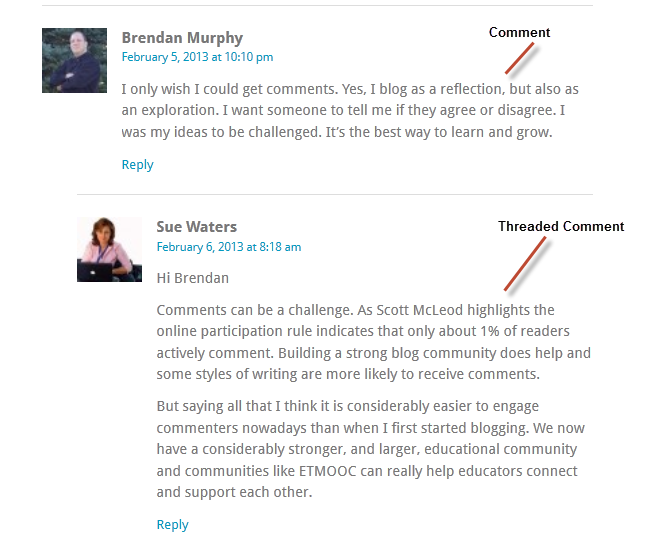


Here are my blogging guidelines – https://drmadelinecraig.edublogs.org/blogging-guidelines/
Thank you for sharing such useful information. I’m a Writer by profession and I found that today’s students are very curious about their homework. The best way is to ask an expert to do my homework. A homework writer is a professional who specializes in crafting high-quality and well-researched academic papers on various subjects and topics.
https://au1.globalassignmenthelp.com.au/do-my-homework
Amazing guide to commenting.
Thank you so much for providing so much valuable content in today’s era.
Thank you for emphasizing the importance of teaching quality commenting skills. It’s crucial for individuals to understand how to provide constructive and meaningful feedback that fosters productive discussions. By teaching these skills, we can create a positive online environment that encourages thoughtful engagement and collaboration.
I also agree with you! I love how they gave both digital options and paper pencil options. I think to build an appropriate scaffold I would start with the poster and sticky note method. Then I would start building in the technology piece. I also think it can be highly engaging and interactive. We learn more by putting our heads together and collaborating with others. I also liked how they provided examples and non examples as well as the continuum of where to begin and the end goal. I think blogging can help students grow in digital citizenship (making sure they are showing appropriate behavior) and help them make meaningful connections with others. This can help students gain new perspectives from peers as well.
I updated my Blog Guidelines page, adding Nicolas Weiss’s video. I used Canva in a previous step to create blogging expectations based on my school’s PBIS model:
https://msfishbein.edublogs.org/wp-admin/post.php?post=15&action=edit
Hello,
I have added a page about me
https://rieska82.edublogs.org/about/about-me/
Hello,
I liked creating the sign on Canva. https://tashielletam1.edublogs.org/good-commenters/
That looks legit! Here’s my commenting guidelines, check it out! https://studentsofknowledge610.edublogs.org/digital-citizenship/
Thanks for this informative blog! I like how the kids are the ones who are explaining how blog commenting works and how it should be done. It would also encourage other young viewers to learn the topic properly and not be lazy in writing complete sentences with correct spellings. I like these interactive materials as well as from this site https://mrbsbrain.com because they know how to get a child’s attention to learn in a fun way. Do you check the submitted comments of your pupils to see if they did a good job?
Comments are important. Reading through I learned to use the TAG method when it comes to leaving a message/comment.
TAG stands for:
Tell them something you like about their work
Ask them a question
Give a suggestion
I like that method as well. I might put that in mine as well.
I like the simplicity of the TAG method. I use a lot of acronyms in my classroom because it helps synthesize processes and makes it easy to remember. I almost want to make an anchor chart titled “TAG” you’re it!
After reading this post, I understood why comments are important. Comments can turn your blog into an interactive post. The constant conversation ignites a huge amount of learning. Online chat can fuel deeper conversations. Students know they have an authentic audience, and this encourages them.
Do you know what encourages them more? If they have a website like Crazy for Study. This website is known for providing accurate textbook solution manuals and 24*7 homework help.
At that time of covid i think online schooling will be only solution right now. like did when i have to apply on exam in bangalore, India. So, i join coaching center like Prasads Academy for preparation of important points.
Hello,
I have added a page about
Quality Blog Comments
with a doc I use with learners to practice writing comments.
I never knew that it can be encouraging for students to know they have an authentic audience who can connect with them. Having a private lesson is making the student more confident in anyways. Thank you for the information about private lessons. https://sheiladugan.com/public-speaking-training/
Hi
Thanks for the quality blogs .Please add more articles for students
I love Kathleen’s poster for a quick guide on commenting. Thank you for that! Also, someone below posted a link to a video created by a teacher at their school, my school teacher at King’s College ( https://kings-college.org ). also help us commenting process.
It sounds like 3 sentences is a good guideline for comments. Do you find it difficult to keep up with reading all the comments?
Hello Iris,
In my experience, commenting needs to be embedded in the learning programme so it is not an extra thing to do but is THE thing for learners and teachers. Of course, learners can be replying to comments as well as teachers.
Regards,
Maria
I thought I knew how important commenting was when blogging before I read this particular step, but now I know I really had no clue! I really appreciated all of the videos that were posted and all of the links to successful blogs. this is a very useful full post thanks it helps me very much
This means any visitors that have had a comment approved on the blog in the past will have their comment immediately posted and only comments from new visitors are placed in the moderation queue. This blog is interesting and helpful page. Thank you so much.
I love Kathleen’s poster for a quick guide on commenting. Thank you for that! Also, someone below posted a link to a video created by a teacher at their school, and it looks great as well!
In previous years I believe I progressed much too quickly from having students comment on the class blog to writing posts. My students never really learned how to compose a quality comment and I believe I didn’t set my expectations of the students high enough! I was happy for them just to be commenting. https://motherboardsguru.com/
Here’s my Quality Comments post added to my blog.
https://popcsmedialab.edublogs.org/category/quality-comments/
Cool thing that Nick Weiss from my school is one of Edublogs’ examples!!
Nick’s video is great! I’m wondering if it is something we can link to on our own sites.
I love how clean and easy to navigate your blog is!
These are simple rules for students to follow as well. Thank you for sharing!
Your commenting for rules are very perfect! I do have them. I believe they are really very important. because I have parents and students on a public account.
100% agree! It’s important to start out with high standards for quality comments and then that becomes the norm.
For this part I created a lesson to along with our accountable talk lessons that we start the year out with. I have also created a Commenting Netiquette page for my students, parents, family, friends, and commentors.
Like the possibility of a rubric as such a plan to check whether a remark is acceptable, during the most recent months with self-teaching, the kids were getting those much of the time with project work to check whether it met the accommodation standards by the instructors.
https://www.bizzlibrary.com/Template/Z4L28/accounting-job-application-letter/
I like the idea of using a rubric. That is something that my students are very familiar with simce I use them all the time.
Your commenting rules are clear and on point. Will be incorporating these for sure!
Did commenting guidelines https://ksredl.edublogs.org/guidlines/
A rubric was created.
Very great knowledge. Looking forward to learn a lot from this site.
Your rules for commenting are perfect! I do have them and I believe they are really important because I have parents and students on a public account.
Rules are important.
https://kamaambong.edublogs.org/2020/06/08/video-editing-self-study/#comment-2
I like the idea of a rubic as a sort of checklist to see if a comment is good. During the last months with homeschooling, the children were getting those frequently with project work to see if it met the submission criteria by the teachers. I am talking about K7 and up students.
I also agree that this is a great concept that should be utilized if applicable.https://tyler67011.edublogs.org/2021/02/09/commenting-guidelines/
My little nephew needs to learn how to read better. It is good to know that he will want to consider getting his parents involved in the process of him learning to read. Also, it might be smart for them to know where he should be at for his age. He will be going into the second grade in August. https://amylemons.com/reading/
Thank you so much for this resource! I enjoyed reading through it very much. I was wondering if anyone here had any resources for professional development? I am currently a college student about to graduate with my teaching degree and I want to get a head start on my Professional Learning Standards!
I enjoyed reading about the blog cycle.
The best part about comments is moderation & approval. It is your hands whether you approve a comment or not.
I created a survey! It was very accessible to them. They did not even have to click a link, it was right on the discussion. It was so awesome!
I’m wondering if teachers struggle with making their blogs public and allowing anyone access to their students?
Yes, but normally these matters are school policy, so have a look what your school has to say. For me, when the parents approve, I can post the student’s work, but no faces of students visible. Furthermore, the names of the students cannot be derived out of the email addresses, and they are also not supposed to give away any personal details. Therefore, moderation is key, at least until they have got used to the rules.
I made a page for my commenting guidelines, it wasn’t in the activities, but I felt this was just as productive as the other ideas given. https://bhilditch.edublogs.org/commenting-guidleines/
Great idea having commenting guidelines for both students and parents, we should include it in the activities!
Your commenting guidelines are great! I have them as well and feel they are very necessary when having a public account for parents and students.
NYMU -Our intellectual environment inspires and challenges our students and staff so that they can extend the scope of academic disciplines and benefit society.
http://www.nymu.org/